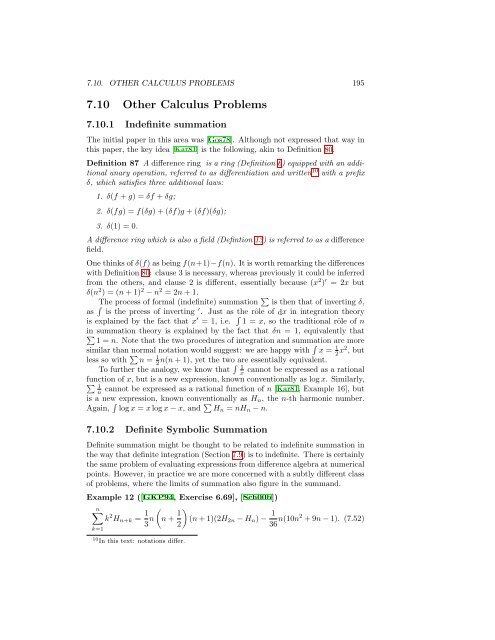Contents - Student subdomain for University of Bath
Contents - Student subdomain for University of Bath
Contents - Student subdomain for University of Bath
Create successful ePaper yourself
Turn your PDF publications into a flip-book with our unique Google optimized e-Paper software.
7.10. OTHER CALCULUS PROBLEMS 195<br />
7.10 Other Calculus Problems<br />
7.10.1 Indefinite summation<br />
The initial paper in this area was [Gos78]. Although not expressed that way in<br />
this paper, the key idea [Kar81] is the following, akin to Definition 80.<br />
Definition 87 A difference ring is a ring (Definition 6) equipped with an additional<br />
unary operation, referred to as differentiation and written 10 with a prefix<br />
δ, which satisfies three additional laws:<br />
1. δ(f + g) = δf + δg;<br />
2. δ(fg) = f(δg) + (δf)g + (δf)(δg);<br />
3. δ(1) = 0.<br />
A difference ring which is also a field (Defintion 13) is referred to as a difference<br />
field.<br />
One thinks <strong>of</strong> δ(f) as being f(n+1)−f(n). It is worth remarking the differences<br />
with Definition 80: clause 3 is necessary, whereas previously it could be inferred<br />
from the others, and clause 2 is different, essentially because (x 2 ) ′ = 2x but<br />
δ(n 2 ) = (n + 1) 2 − n 2 = 2n + 1.<br />
The process <strong>of</strong> <strong>for</strong>mal (indefinite) summation ∑ is then that <strong>of</strong> inverting δ,<br />
as ∫ is the prcess <strong>of</strong> inverting ′ . Just as ∫the rôle <strong>of</strong> dx in integration theory<br />
is explained by the fact that x ′ = 1, i.e. 1 = x, so the traditional rôle <strong>of</strong> n<br />
∑<br />
in summation theory is explained by the fact that δn = 1, equivalently that<br />
1 = n. Note that the two procedures <strong>of</strong> integration and summation are more<br />
similar than normal notation would suggest: we are happy with ∫ x = 1 2 x2 , but<br />
less so with ∑ n = 1 2n(n + 1), yet the two are essentially equivalent.<br />
To further the analogy, we know that ∫ 1<br />
x<br />
cannot be expressed as a rational<br />
∑<br />
function <strong>of</strong> x, but is a new expression, known conventionally as log x. Similarly,<br />
1<br />
n<br />
cannot be expressed as a rational function <strong>of</strong> n [Kar81, Example 16], but<br />
is a new expression, known conventionally as H n , the n-th harmonic number.<br />
Again, ∫ log x = x log x − x, and ∑ H n = nH n − n.<br />
7.10.2 Definite Symbolic Summation<br />
Definite summation might be thought to be related to indefinite summation in<br />
the way that definite integration (Section 7.9) is to indefinite. There is certainly<br />
the same problem <strong>of</strong> evaluating expressions from difference algebra at numerical<br />
points. However, in practice we are more concerned with a subtly different class<br />
<strong>of</strong> problems, where the limits <strong>of</strong> summation also figure in the summand.<br />
Example 12 ([GKP94, Exercise 6.69], [Sch00b])<br />
n∑<br />
k 2 H n+k = 1 (<br />
3 n n + 1 )<br />
(n + 1)(2H 2n − H n ) − 1 2<br />
36 n(10n2 + 9n − 1). (7.52)<br />
k=1<br />
10 In this text: notations differ.












![[Luyben] Process Mod.. - Student subdomain for University of Bath](https://img.yumpu.com/26471077/1/171x260/luyben-process-mod-student-subdomain-for-university-of-bath.jpg?quality=85)



